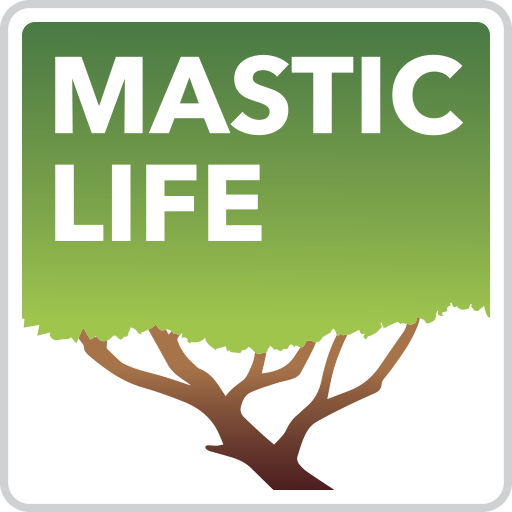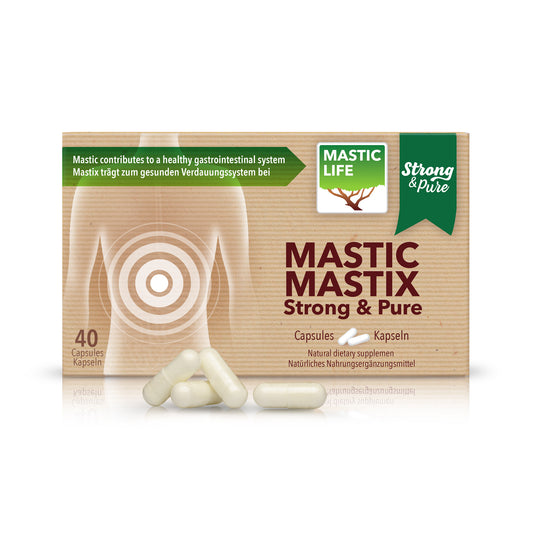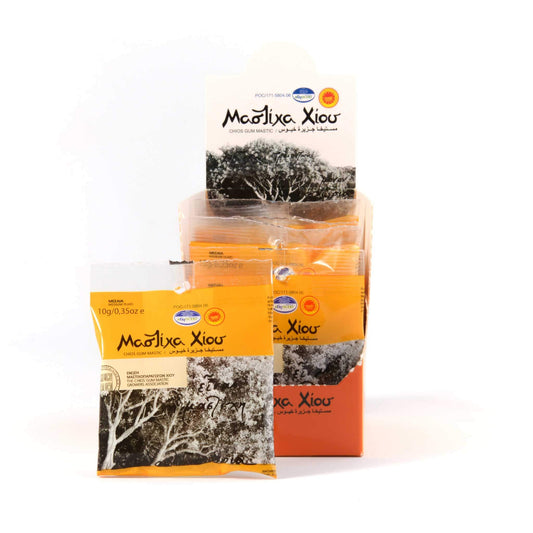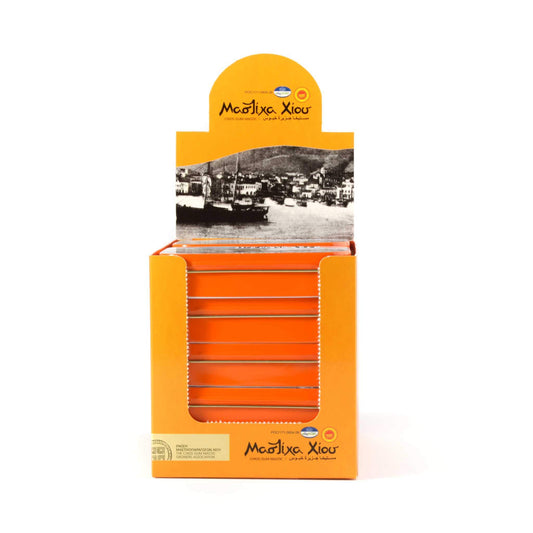Studies: GASTRO-INTESTINAL ACTIVITY OF CHIOS MASTIC
- gastralgia
- digestive ulcers
Study 1
The first double-blind clinical trial took place in 1984. Precisely, 38 patients with symptomatic and endoscopically proven duodenal ulcer participated in a trial aiming at comparing the response to Chios mastic (1g per day, 20 patients) and placebo (lactose, 1g per day, 18 patients) orally administered for over 2 weeks. A percentage of 80% of the patients on Chios mastic experienced alleviation from the relevant symptoms, compared to 50% of the placebo. Additionally, 70% of Chios mastic patients posed endoscopically proven healing, in comparison with 22% of the other group’s patients. Chios mastic did not cause any side effects. To conclude, Chios mastic possesses an ulcer healing activity. 1
Study 2
Al-Said et al (1984) studied the effect of Chios mastic on experimental gastric and duodenal ulcers. Chios mastic orally ingested in rats at 500mg/kg remarkably decreased the intensity of gastric mucosal damage. Moreover, Chios mastic administartion caused a notable reduction of free acidity and a marked cytoprotective activity. Interestingly, the protective action was absent in intraperitoneal administration. A mild antisecretory and a localized adaptive cytoprotectant effect might be responsible for its anti-ulcer activity. 2
Study 3
In 1997, Gabr investigated co-precipitates and physical mixtures of indomethacin, lactose and Chios mastic in rats, aiming to approach Chios mastic’s activity on drug dissolution rate, bioavailability and ulcerogenic activity. The preparations were administered orally. Interestingly, Chios mastic delayed drug dissolution rate. Regarding bioavailability, the findings indicate a sustained activity of drug from indomethacin- Chios mastic physical mixture and coprecipitate, and the ulcerogenic effect of indomethacin decreased in all preparations that included Chios mastic. 3
Study 4
In 1998, Huwez et al used H. pylori strains NCTC 11637 and six fresh clinical isolates (three were sensitive and three were resistant to metronidazole). Chios mastic was prepared as a stock solution in ethanol at a concentration of 50mg/ml and was diluted in the broth culture which contained 107 cells/ml of H. pylori, for a final concentration from 0.0075 to 1.0 mg/ml. After the incubation, 10-μl aliquots were obtained and placed on agar plates at various times for up to 48 hours. Chios mastic killed the H. pylori NCTC 11637 strain and the six clinical isolates (reduction in the viable count by a factor of 1000) regardless the organism’s susceptibility to nitroimidazoles. The minimal bactericidal concentration at 24 hours for all strains was equal to 0.06 mg of the crude Chios mastic per ml. It is worth mentioning that in lower concentrations, the growth of H. pylori was still significantly inhibited, with a clear post-antibiotic effect even at the lowest concentration which was used. Furthermore, Chios mastic made clear ultrastructural modifications in the bacteria, as demonstrated by transmission electron microscopy. Chios mastic exhibits definite antibacterial activity against H. pylori, which may partly explain its anti–peptic-ulcer properties, and the analysis of the anti–H. pylori activity of the various components of Chios mastic may pinpoint the active ingredient. 4
Study 5
Marone et al (2001) investigated the bactericidal activity of Chios mastic against H. pylori against clinical isolates of the bacterium. Chios mastic killed 50% of the strains tested at a concentration of 125μg/ml and 90% at a concentration of 500μg/ml. The influence of sub- minimal bactericidal concentrations of Chios mastic on the morphologies of H. pylori was assessed by transmission electron microscopy. Interestingly, the resin generated blebbing, morphological abnormalities and cellular fragmentation in H. pylori cells. To conclude, Chios mastic induced fair antibacterial activity against H. pylori cells. 5
Study 6
The objective, in another study conducted in 2001 (Bona et al), was to clarify the bactericidal activity of Chios mastic against H. pylori. Twelve clinically isolated strains were used. More precisely, 4 strains were susceptible to clarithromycin and metronidazole, 4 strains were resistant to clarithromycin and 4 strains were resistant to clarithromycin and metronidazole. Chios mastic killed 50% of the strains tested at a concentration of 125μg/ml while the minimal bactericidal concentration was 90μg/ml. Moreover, the strains susceptible to clarithromycin and metronidazole were inhibited at a concentration of 62.5μg/ml of Chios mastic. Thus, Chios mastic showed a good antibacterial activity against H. pylori. 6
Study 7
In 2003, Roe et al examined the activity of Chios mastic gum on individuals with H.pylori infected gastritis. Specifically, 48 subjects participated in a double blind clinical trial, who were allocated into two groups, treated with Chios mastic or placebo, 3 times daily for 15 minutes, for a total period of 90 days. Researchers concluded that Chios mastic has an advantageous effect against H. pylori infected gastritis. 7
Study 8
Heo et al (2006) focused on investigating whether Chios mastic oil may decrease diclofenac induced gut damage and bacterial translocation in rats. The oil demonstrated remarkable protective activity, compared to diclofenac which caused augmentation of the enteric bacterial numbers and bacterial translocation, decreased with Chios mastic co-administration. Therefore, Chios mastic was proven to exhibit beneficial properties in preventing non-steroidal anti-inflammatory drug induced gut injury and bacterial translocation in rats. 8
Study 9
Paraschos et al (2007) examined the in vitro and in vivo activities of Chios mastic extracts and constituents against H. pylori. The extracts and pure constituents of Chios mastic were investigated with regards to their anti-H.pylori effect. A total Chios mastic extract without polymer (TMEWP) was prepared after the removal of the insoluble polymer for improving solubility and amelioration in vivo activity. The TMeWP was administered to H. pylori SS1-infected mice over 3 months. The average dose of Chios mastic was equal to 0.75 mg/day and resulted in an approximately 30-fold decrease in the H. pylori colonization. Additionally, Chios mastic extracts and isolated pure triterpenic acids were tested for their in vitro effect against 11 H. pylori clinical strains. The acid fraction of Chios mastic was proven to be the most active extract (minimum bactericidal concentration 0.139 mg/ml), and the most active pure component was isomasticadienolic acid (minimum bactericidal concentration, 0.202 mg/ml [0.443 mM]). Conclusively, administration of TMEWP may be effective in decreasing H. pylori colonization. Furthermore, the major triterpenic acids in the acidic fraction may be responsible for this effect. 9
Study 10
In 2007, a research group aimed at assessing the effectiveness of Chios mastic administration on the clinical course and plasma inflammatory mediators of patients who suffer from active Crohn’s disease (CD). The outcome of the study showed that Chios mastic significantly reduced the activity index and the plasma levels of nterleukin-6 and C-reactive protein in patients with mildly to moderately active CD. 10
Study 11
As regards the effect of Chios mastic administration on cytokine production of circulating mononuclear cells of patients with active Crohn’s disease (CD), Chios mastic was shown to act as an immunomodulator inhibiting tumor necrosis factor-alpha (TNF-α) and stimulating macrophage migration inhibitory factor. Although further double-blind placebo-controlled studies in more patients are needed to establish this immunomodulating effect of Chios mastic, the present study indicates that Chios mastic might be an important regulator of immunity in CD. 11
Study 12
Kottakis et al (2008) studied arabino-galactan proteins isolated from Chios mastic. Trials on the inhibition of growth of H. pylori in the presence of the above mentioned proteins, demonstrated that the extracts of at least 1.4 g Chios mastic affected theviability of bacteria. The research group suggested that such proteins from Chios mastic induce morphologic alterations in H. pylori and hence, inhibit its in vitro growth. However, this has to be further explored in live organisms. 12
Study 13
In 2009 research team investigated Chios mastic activity on innate cellular immune effectors. More precisely, Chios mastic-extracted arabinogalactan proteins were tested both in vitro and in vivo, under the presence of H. pylori neutrophil-activating protein, on the innate cellular immune effectors, for the comparison of 5 H. pylori-infected patients and 3 healthy controls. Participants received 1g of Chios mastic daily for 2 months. Arabinogalactans in Chios mastic inhibit neutrophil activation in the presence of H. pylori neutrophil-activating protein, playing a vital role in H. pylori-linked pathologies in gastric mucosa. 13
Study 14
Hassan (2009) studied the inhibitory effect of different concentrations of certain plant mucilages and gums (including P. lentiscus gum) on specific intestinal disaccharidases. Chios mastic possessed the highest inhibitory activity against intestinal invertase, maltase and lactase. 14
Study 15
Dabos et al (2010) investigated the effect of pure Chios mastic on H. pylori decrease and eradication, in individuals suffering from H. pylori infection. Precisely, 52 patients were randomized and divided into four groups. Group A received 350mg of pure Chios mastic three times daily, Group B received 1.05g of pure Chios mastic three times daily, Group C received pantoprazole 20mg twice daily plus pure Chios mastic 350mg three times daily, and Group D received pantoprazole 20mg twice a day plus amoxicillin 1g twice a day plus clarithromycin 500mg twice a day. The duration of the study equaled 14 days for Groups A, B and C, and 10 days for Group D. Interestingly, eradication of the bacteria was confirmed in 30.8% of patients in Group A and in 38.5% in Group B. Eradication wasn’t obtained in any patient in Group C. Additionally, 76.92% of patients in Group D had a negative urea breath test. Chios mastic was tolerated well by all participants and no side effects were reported. Thus, Chios mastic shows in vivo bactericidal activity on H. pylori. 15
Study 16
During the same year, Dabos et al investigated the efficacy of Chios mastic in patients with functional dyspepsia. In paricular, 148 patients who fullfilled Rome II criteria for functional dyspepsia were randomly assigned to receive 350mg of Chios mastic three times daily or placebo. The study lasted for 3 weeks. Afterwards, the modification in the severity of symptoms of functional dyspepsia was assessed, as well as the subjects’ global assessment of efficacy. Interestingly, the symptom score after treatment was significantly lower in Chios mastic (14.78±1.78) compared to the placebo group (19.96±1.83). Furthermore, in 40% of patients receiving placebo and in 77% of patients receiving Chios mastic there was a remarkable improvement of symptoms. Stomach pain in general, stomach pain when anxious, dull ache in the upper abdomen and heartburn belong to the individual symptoms that demonstrated notable improvement with Chios mastic. Therefore, Chios mastic significantly improves symptoms in patients with functional dyspepsia compared to the placebo group. 16
Study 17
In 2011, Gioxari et al conducted a study based upon the hypothesis that Chios mastic inhibits intestinal damage in the inflammatory bowel disease, regulating inflammation and oxidative stress in intestinal epithelium. Particularly, 4 doses of P. Lentiscus powder were orally administered in TNBS-colitic rats. As a result, daily administration of 100 mg of Chios mastic powder/kg of body weight caused a reduction in all inflammatory cytokines. Hence, Chios mastic may potentially exert a therapeutic effect in Crohn’s disease, regulating oxidant and/or antioxidant balance and modulating inflammation. 17
Study 18
In 2012, Kountouras et al claimed that the co-administration of Chios mastic, with a Helicobacter eradication regimen may cause clinical advantages against H. pylori. However, Chios mastic possibly was not the main therapy. H. pylori neutrophil-activating protein is a promising vaccine candidate against H.pylori infection. Finally, the above mentioned protein is also important in the pathogenesis in both gastric and colon oncogenesis. 18
Study 19
Based on the hypothesis that terpenoids exhibit functional activities via distinguishable pathways, Papalois et al (2012) fractionated Chios mastic and applied different fractions or individual oleanolic acid in experimental colitis. Furthermore, the research group investigated the mechanism underlying this effect in human colon epithelial cells. In vivo, histological amelioration of colitis and significant regulation in inflammation occurred with Chios mastic powder, even at the mRNA level. Inulin was ineffective. In vitro, Chios mastic treatment down-regulated inflammatory IL-8 and NF-κB p65. Because, neitherisolated fractions nor individual oleanolic acid were the bioactive component solely, most probably, the entire Chios mastic, rather than its individual fractions, reduces inflammation via NF-κB regulation. 19
Study 20
In 2014, Miyamoto et al studied the chemical composition of Chios mastic essential oil and its antibacterial effects against drug-resistant H. pylori. More specifically, this study tried to approach which substance of Chios mastic was responsible for presenting anti-H. pylori activity. Interestingly, 20 constituents were identified by GC–MS. Ten standard components were assayed for anti-H.pylori activity, and it was clear that α-terpineol and (e)-methyl isoeugenol showdemonstrated the anti-H.pylori action against 4 different H. pylori strains that were clinically isolated from patients with gastritis, gastric ulcer and gastric cancer. As a conclusion, these compounds could be useful to overcome the drug- resistant H. pylori growth in the gastric environment. 20
Study 21
A double blind and placebo controlled clinical trial in 128 IBD patients showed, for the first time, that a supplement prepared with mastic could be served as an innovative treatment approach as an adjunct to conventional medical therapy. Regulation of faecal lysozyme in active patients points to a prebiotic effect. Additionally, the amelioration of increases in faecal lactoferrin and faecal calprotectin confirms its anti-inflammatory effect in active IBD 21. Furthermore, in IBD patients in remission, the amelioration in increased plasma amino acids indicates a role of mastic in limiting activity of IBD 22.

----------------------------------------------------------------------------------------------
1. Al-Habbal M.J., Al-Habbal Z., Huwez F.U. [1984]: A double-blind controlled clinical trial of mastic and placebo in the treatment of duodenal ulcer. Clin Exp Pharmacol Physiol., 11 (5): 541-544.
2. Al-Said M.S., Ageel A.M., Parmar N.S., Tariq M. [1984]: Evaluation of mastic, a crude drug obtained from Pistacia Lentiscus for gastric and duodenal antiulcer activity. J Ethnopharmacol., 15 (3): 271-278.
3. Gabr K.E. [1997]: Influence of indomethacin-mastic combinations on dissolution, absorption and gastroin- testinal mucosal damage in rats. Int. J. of Pharm., 158: 137–145.
4. Huwez F.U., Thirlwell D., Cockayne A., Ala’Aldeen D.A.A. [1998]: Mastic Gum Kills Helicobacter pylori. N. Eng. J. of Med., 339 (26): 1946
5. Marone P., Bono L., Leone E., Bona S., Carretto E., Perversi L. [2001]: Bactericidal activity of Pistacia Len- tiscus mastic gum against Helicobacter pylori. J Chemother., 13 (6): pp 611-614.
6. Bona S.G., Bono L., Daghetta L., Marone P. [2001]: Bactericidal activity of Pistacia Lentiscus gum mastic against Helicobacter pylori. The Am. J. of Gastroenterol., 96 (9) Supplement 1: S49.
7. Roe I.H., Nam S.W., Myung N.H., Kim J.T., Shin J.H. [2003]: The effect of mastic gum on Helicobacter pylori-in- fected gastritis. Korean J. Gastroenterol., 41: 277-283.
8. Heo C., Kim D.W., Do J.H. [2006]: Protective effects of mastic in non-steroidal anti-inflammatory drug in- duced gut damage and bacterial translocation in a rat model. Korean J. Med., 71: 354-361.
9. Paraschos S., Magiatis P., Mitakou S., Petraki K., Kalliaropoulos A., Maragkoudakis P., Mentis A., Sgouras D., Skaltsounis A.-L. [2007]: In vitro and in vivo activities of Chios mastic gum extracts and constituents against Helicobacter pylori. Antimicrob. Agents Chemother., 51 (2): 551–559.
10. Kaliora A.C., Stathopoulou M.G., Triantafillidis J.K., Dedoussis G.V.Z., Andrikopoulos N.K. [2007]: Chios mas- tic treatment of patients with active Crohn’s disease. World J Gastroenterol., 13 (5): 748-753.
11. Kaliora A.C., Stathopoulou M.G., Triantafillidis J.K., Dedoussis G.V.Z., Andrikopoulos N.K. [2007]: Alterations in the function of circulating mononuclear cells derived from patients with Crohn’s disease treated with mas- tic. World J Gastroenterol., 13(45): 6031-6036.
12. Kottakis F., Lamari F., Matragkou C., Zachariadis G., Karamanos N., Choli-Papadopoulou T. [2007]: Arabi- no-Galactan proteins from Pistacia lentiscus var. chia: isolation, characterization and biological function. Amino Acids, 34: 413-420.
13. Kottakis F., Kouzi-Koliakou K., Pendas S., Kountouras J., Choli-Papadopoulou T. [2009]: Effects of mastic
gum Pistacia lentiscus var. chia on innate cellular immune effectors. Eur. J. of Gastroenterol. & Hepatol., 21(2): 143-149.
14. Hassan H.M.M. [2009]: Inhibitory Activities of Some Mucilages and Gums Against Certain Intestinal Disac- charidases. Austr. J. Basic & App. Sci., 3 (3): 2741-2746.
15. Dabos K.J., Sfika E., Vlatta L.J., Giannikopoulos G. [2010]: The effect of mastic gum in Helicobacter pylori: A randomized study. Phytomedicine, 17 (3-4): 296-299.
16. Dabos K.J., Sfika E., Vlatta L.J., Frantzi D., Amygdalos G.I., Giannikopoulos G. [2010]: Is Chios mastic gum effective in the treatment of functional dyspepsia? A prospective randomised double-blind placebo controlled trial. J of Ethnopharmacology, 127 (2): 205–209.
17. Gioxari A., Kaliora A.C., Papalois A., Agrogiannis G., Triantafillidis J.K., Andrikopoulos N.K. [2011]: Pistacia lentiscus resin regulates intestinal damage and inflammation in trinitrobenzene sulfonic acid-induced colitis. J. Med. Food, 14 (11): 1403-1411.
18. Kountouras J., Zavos C., Deretzi G., Gavalas E., Chatzopoulos D., Katsinelos P., Tsiaousi E., Gagalis S., Polyzos S.A., Venizelos I. [2012]: Potential implications of Helicobacter pylori-related neutrophil-activating protein. World J. Gastroenterol., 18 (5): 489-490.
19. Papalois A., Gioxari A., Kaliora A.C., Lymperopoulou A., Agrogiannis G., Papada E., Andrikopoulos N.K. [2012]: Chios mastic fractions in experimental colitis: implication of the nuclear factor κB pathway in cultured HT29 cells. J. Med. Food, 15 (11): 974-983.
20. Miyamoto T., Okimoto T., Kuwano M. [2014]: Chemical composition of the essential oil of mastic gum and their antibacterial activity against drug-resistant Helicobacter pylori. Nat. Prod. Bioprospect., 4(4): 227–231.
21. Papada E, Gioxari A, Amerik;anou C, Forbes A, Tzavara C, Smyrnioudis I, Kaliora AC, Regulation of Faecal biomarkers in inflammatory bowel disease patients treated with oral mastic (Pistacia Lentiscus) supplement: A double-bind and placebo-controlled randomized trial. Phytother Res. 2018 Nov. 18 doi:10.1002/ptr.6229.
22. Papada E, Amerikanou C, Torović L, Kalogeropoulos N., Kaliora AC. Plasma free amino acid profile in quiescent Inflammatory Bowel Disease patients orally administered with mastic (Pistacia lentiscus); a randomised clinical trial. Phytomedicine, Volume 56, 15 March 2019, Pages 40-47.
Mastic for your gastrointestinal tract
-
Mastic Strong&Pure Economy Pack (240 Capsules) Masticlife
Regular price €85.90 EURRegular priceUnit price / per -
Mastic Strong&Pure (40 Capsules) Masticlife
Regular price €15.90 EURRegular priceUnit price / per -
Mastic Chios Raw Tears Medium Size 10 g
Regular price From €4.99 EURRegular priceUnit price / per€49.90 EURSale price From €4.99 EURSale -
Mastic Chios Raw Tears Medium Size 20 g
Regular price From €9.99 EURRegular priceUnit price / per€99.90 EURSale price From €9.99 EURSale




